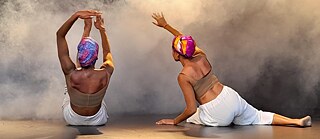Two portraits Dance as a means of research

What happens when you take traditional cultural practices out of their context and put them on stage? What does it take to do this respectfully and attentively? A portrait of dancers Luana Madikera and Khadidiatou Bangoura, who are exploring these questions together in Montreal.
Both grew up in France before coming to Germany. “My family comes from Liberia and Guinea in West Africa”, says Bangoura. “For me, it's the Caribbean islands of Guadeloupe and Martinique”, says Madikera, “where my West African ancestors were deported to”. Much of the original Afro-Caribbean culture was lost in the process, which she tries to discover and understand in her artistic practice through music and dance.
During their collaborative research, they quickly realised that there were many questions that needed to be asked: How do you respectfully transfer cultural practices? Should it be done at all, and for whom could it add value? In Montreal, they plan to extend these considerations to ceremonies in other African countries, and explore whether there is a way to carefully and thoughtfully incorporate the original material into creative processes.
Dancing was never a hobby for me
In Paris, Lisbon and London, she learnt about urban dance styles from Ghana, Angola, South Africa, Congo and Côte d'Ivoire and soon began teaching modern Afro fusion classes herself. She became a member of the One Vibe dance school and co-founder of the tropical bass band La Byle. “We all come from Brazil or the Caribbean and have one foot in Berlin”, she says. Their music is strongly influenced by hip hop, baile funk and Afrohouse, and they sing in Portuguese, English, Kreyol, French and German.
In 2022, she completed her first professional dance training with the “Advanced Dance Programme” at Studio 29 in Berlin, where she learnt about Eurocentric styles such as jazz, ballet and contemporary. In 2023, she continued her training with the “Diaspora Africa” programme at the renowned École des Sables in Senegal, an international centre for traditional and contemporary dances from Africa and the West. She would now also describe herself as a contemporary dancer, says Madikera, with projects at the Deutsche Oper Berlin, the KW Institute for Contemporary Art Berlin and Kampnagel in Hamburg.
This is where the two artists complement each other in their research, as Khadidiatou Bangoura has been making a name for herself as a dancer and choreographer in Cologne's independent dance scene for four years. She found her way to professional dance in London, where she studied International Relations and Development Co-operation “to contribute to the progress of African countries”, as she says. The countless opportunities that the English capital had to offer in dance were fascinating and she attended dance classes with international artists. “International collaboration can certainly achieve good things, but it was then that I realised there were other ways”.
We all have our own body language.
In Montreal, Madikera and Bangoura want to find out how their artistic and political positions change as a result of their research and how this affects their art. They want to scrutinise and examine the concept of ritual. Because this word is associated with a value judgement that exoticises and demonises cultures and portrays spirituality as something negative. “These images are relics of colonialism that were intended to destroy entire cultures. So the question for us is: what words are there to describe these ceremonies, these dance and musical practices, without judging them and robbing them of their meaning?”
Dance is a suitable tool for this because it offers the opportunity to rediscover, discover and understand one's own culture. “We can also use it to express and process our feelings, which is why I am also interested in its psychosomatic aspects”, explains Luana Madikera. Her view of dance has changed considerably over time: “I appreciate that traditional dances such as the Gwoka from Guadeloupe were created in resistance and that they can influence the further development of my dance practice.”
During their research in Montreal, the two dancers not only want to attend dance classes and conduct research on the level of body and movement, but also exchange ideas with other Afro-diasporic and indigenous artists on site.
“Here in Canada, themes of North American history and First Nations play an important role. We are interested in finding out to what extent our questions, which are also a product of colonialism, play a role in the work of indigenous artists”, says Bangoura. The two also want to let themselves drift through the city and discover its architecture and culture. “All of this influences and stimulate the process and we hope that we can learn a lot. Because our feeling is that we are opening a door to something that will last longer.”